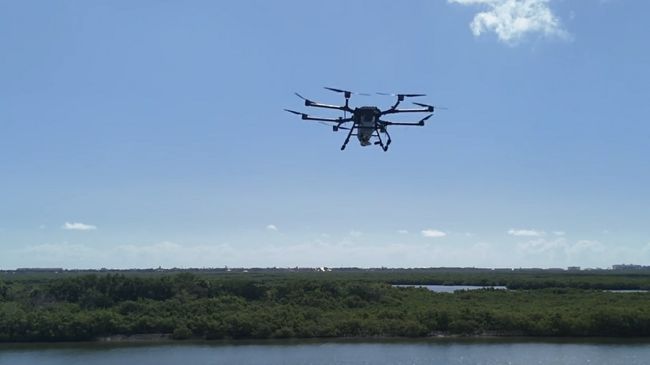Coastal Conservation Association Florida, Duke Energy and Others Continue Indian River Lagoon Billion Clam Initiative
On June 24, 2024, Coastal Conservation Association Florida (CCA Florida), alongside Duke Energy, Florida Fish and Wildlife Conservation Commission (FWC), and the University of Florida (UF) Whitney Lab, advanced the Indian River Lagoon (IRL) Billion Clam Initiative by deploying 2 million clams using patented drone technology. This innovative method aims to restore the IRL's ecosystem by planting clams at specific locations and densities, accelerating their maturation and overcoming predation pressures.
Since 2017, the initiative has planted 40 million clams, and in October 2023, CCA Florida and Duke Energy donated $100,000 to support the project. The effort is expected to improve water quality and clarity by utilizing clams' natural filtering abilities, which in turn supports the growth of essential seagrasses. Duke Energy's Crystal River Mariculture Center has also contributed significantly, releasing nearly 5 million fish and crustaceans and donating $200,000 worth of aquatic vegetation for various habitat restoration projects across Florida.
- Deployment of 2 million clams using advanced drone technology.
- Since 2017, 40 million clams planted in IRL.
- CCA Florida and Duke Energy donated $100,000 in October 2023.
- Improvement in water quality and support for seagrass growth.
- Duke Energy's Mariculture Center has released nearly 5 million fish and crustaceans.
- Duke Energy donated $200,000 worth of aquatic vegetation for restoration projects.
- None.
(Coastal Conservation Association Florida issued the following news release on June 5, 2024.)
- The team deployed 2 million clams in the IRL using state-of-the-art drone for precise distribution
EDGEWATER, FL / ACCESSWIRE / June 24, 2024 / Coastal Conservation Association Florida (CCA Florida), the state's leading organization dedicated to marine fisheries conservation, education and advocacy, joined Duke Energy, Capt. Blair Wiggins of Indian River Lagoon Clam Restoration Project, the Florida Fish and Wildlife Conservation Commission (FWC) and University of Florida (UF) Whitney Lab at the Riverside Conservancy Center to deploy 2 million clams using patented drone and continue their efforts for the Indian River Lagoon (IRL) Billion Clam Initiative.
The Billion Clam Initiative focuses on revitalizing and preserving the delicate ecosystem in the IRL by using state-of-the-art technology to systematically distribute clams on a large-scale basis.
The advantage of spreading clams with a drone will help overcome predation pressures and enable larger numbers of clams to be restored to the IRL. Drone distribution will also help plant clams in specific locations and densities, vastly accelerating the maturation process when compared to manual spreading.
"The Billion Clam Initiative is a broad-scale, science-backed collaborative effort that is using innovative technologies to drop millions of clams into the IRL." CCA Florida Director of Habitat and Environmental Restoration Frank Gidus said. "We are proud to work with our awesome partners, like the Duke Energy Mariculture Center, as our efforts are improving the water quality in the Lagoon for today and generations to come."
Since 2017, the partners have planted 40 million clams in the IRL. To help kickstart the Billion Clam Initiative, CCA Florida and the Duke Energy donated
"Duke Energy's Crystal River Mariculture Center has grown into one of Florida's most successful fish hatcheries and conservation allies," said Sharon Arroyo, Duke Energy Florida vice president of government and community relations. "To date, Duke Energy and its Mariculture Center, with help from CCA Florida, have released nearly 5 million fish and crustaceans along Florida's coasts and has donated approximately
Clams are filter feeders, removing excess nutrients from inshore coastal waters, as a result, creating clearer water. Improved water clarity allows more sunlight to penetrate the ecosystem and supports the growth of essential seagrasses, a vital need for the IRL. The restorative work from the clam planting will form the foundation for rebuilding shellfish populations, benefitting the needs for today and tomorrow.
About CCA Florida
The Coastal Conservation Association (CCA) was founded in 1977 after drastic commercial overfishing along the Texas coast decimated redfish and speckled trout populations. One of 19 state chapters, CCA Florida became the fifth state chapter in 1985. A 501(c)3 non-profit, the purpose of CCA is to advise and educate the public on conservation of marine resources. Through habitat restoration projects, water quality initiatives and fisheries advocacy, CCA Florida works with its over 18,000 members including recreational anglers and outdoor enthusiasts to conserve and enhance marine resources and coastal environments. Join the conversation on Facebook or learn more at ccaflorida.org.
About Duke Energy Florida
Duke Energy Florida, a subsidiary of Duke Energy, owns 12,300 megawatts of energy capacity, supplying electricity to 2 million residential, commercial and industrial customers across a 13,000-square-mile service area in Florida.
Duke Energy (NYSE: DUK), a Fortune 150 company headquartered in Charlotte, N.C., is one of America's largest energy holding companies. The company's electric utilities serve 8.4 million customers in North Carolina, South Carolina, Florida, Indiana, Ohio and Kentucky, and collectively own 54,800 megawatts of energy capacity. Its natural gas utilities serve 1.7 million customers in North Carolina, South Carolina, Tennessee, Ohio and Kentucky.
Duke Energy is executing an ambitious clean energy transition, keeping reliability, affordability and accessibility at the forefront as the company works toward net-zero methane emissions from its natural gas business by 2030 and net-zero carbon emissions from electricity generation by 2050.
The company is investing in major electric grid upgrades and cleaner generation, including expanded energy storage, renewables, natural gas and nuclear.
More information is available at duke-energy.com and the Duke Energy News Center. Follow Duke Energy on Twitter, LinkedIn, Instagram and Facebook, and visit illumination for stories about the people and innovations powering our energy transition.
Duke Energy Media contact: Audrey Stasko
Media line: 800.559.3853
CCA Media Contact: Mary Hillyer Peelen Walther
Phone: 407.617.0604
Email: mhpwalther@ccaflorida.org
View original content here.

View additional multimedia and more ESG storytelling from Duke Energy on 3blmedia.com.
Contact Info:
Spokesperson: Duke Energy
Website: https://www.3blmedia.com/profiles/duke-energy
Email: info@3blmedia.com
SOURCE: Duke Energy
View the original press release on accesswire.com







